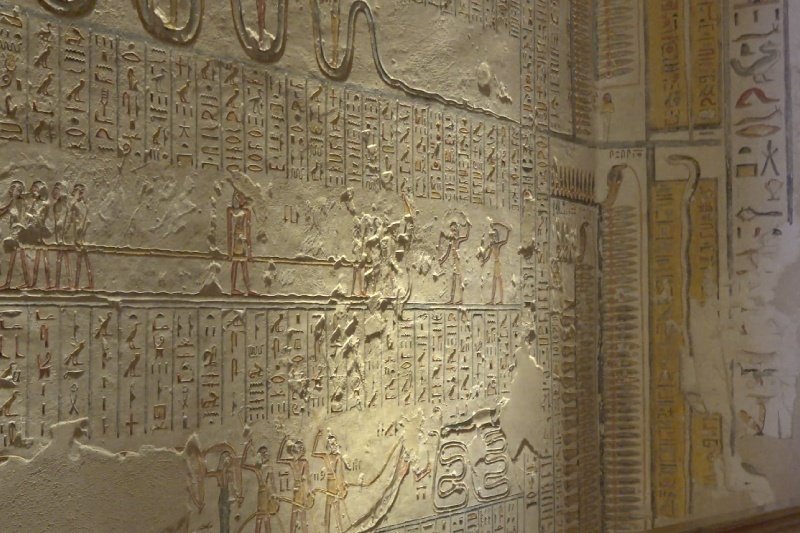
Tomb of Ramesses VI 3D Scanning Project - WORLD SCAN PROJECT’s Challenge
The Valley of the Kings, the final resting place of the Pharaohs, is home to numerous tombs of great archaeological value. Among them, the tomb of Ramesses VI is particularly famous for its surreal beauty, which attracts widespread admiration. In this article, we will present the interior of Ramesses VI's tomb, along with the results of our World Scan Project (W.S.P) investigation.
Ancient Egyptian pharaoh of the 20th Dynasty : Ramesses VI
Born to Ramesses III and Iset Ta-Hemdjert, Ramesses VI ascended the throne during the New Kingdom period as the pharaoh of the 20th dynasty.
During this time, the situation was unstable, and the continued political interference of the priesthood and the outbreak of riots from the previous reign led to a steady decline in the nation's power.
Constructed during this period of decline, the tomb of Ramesses VI, located next to that of Tutankhamun, was originally planned for his predecessor pharaoh and nephew, Ramesses V. However, during the 20th dynasty, Ramesses VI overwrote the inscriptions bearing Ramesses V's name, enlarged the tomb, and usurped it.

The interior of the tomb of Ramesses VI
Inside the royal tomb, the passage leading from the entrance is adorned with magnificent murals deeply rooted in religion and views of life and death. These include the "Book of Caverns," which depicts the sun god Ra's journey through the underworld after setting in the west and rising in the east at dawn, and the "Book of Gates," a funerary text about the 12 gates in the underworld.
The aged, ram-headed sun god is shown traveling through the caves with the aid of a walking stick, and scenes remain of those who opposed the sun god Ra, depicted with their heads, hearts, and bodies consumed by fire by the gods within the caves.



In addition, the Nile was indispensable to the ancient Egyptians, but there is also a river in the underworld on which the sun god Ra travels by boat. On the eastern side, divided by the river, the good man is depicted, while on the western side those who oppose the sun god are shown bound hand and foot, indicating the fate that awaits Ra's adversaries.


Vivid Murals
As you walk down the long corridor, you will see the vibrant ceiling paintings of deities in yellow against a dark blue sky. Here the sky goddess Nut is vividly depicted swallowing the sun god Ra at sunset and giving birth to him again in the morning from the east. The surrounding columns, decorated with the "Book of Gates," have become an invaluable resource for understanding the ancient Egyptians' views on life, death and the universe.



The story of death and rebirth continues with extracts from the Amduat, the book of the underworld. Baboon, the goddess and the god Khepri, who is depicted as a scarab, are welcome the sun god Ra into the underworld.
The scarab was represented rebirth in ancient Egypt, and the aged ram-headed sun god eventually becomes Khepri, rising from the eastern sky. Similarly, the ancient Egyptians believed that the pharaoh would be resurrected alongside the sun god after his journey through the underworld.

The beautiful burial chamber
The innermost burial chambe is adorned with dazzling decorations, and the colossal sarcophagus in which Ramesses VI once lay still exists today. The sarcophagus of Ramesses VI is positioned so that one can see the vaulted ceiling, inscribed with the "Book of Day" and the "Book of Night," which record the movements of the sun and stars.
The walls are also intricately painted with scenes depicting the resurrection of the god Osiris, known as the "Book of the Earth." These scenes create a space so vivid that it's hard to believe they were painted over 3,000 years ago.




Making the world, the future, and curiosity closer
Inside the tomb of Ramesses VI, numerous funerary texts have been preserved in pristine condition, providing valuable insights into the religious beliefs of the ancient Egyptians and their deep faith in the afterlife.
At the World Scan Project, we aim to bring these ancient legacies closer to everyone by accurately 3D scanning them and realistically reproducing even the finest details of the decorations in VR and the metaverse. This will allow people to explore the interiors of these sites and learn about their historical context without having to travel to the sites themselves.

Through these efforts, we aim to increase interest in these archaeological sites and raise awareness of their preservation. We will continue to pass on the baton of history to the next generation through digital technology. We invite you to follow the activities of the World Scan Project and join us on our journey.
Please also check out this video about Tomb of Ramesses VI.
この記事が気に入ったらサポートをしてみませんか?
